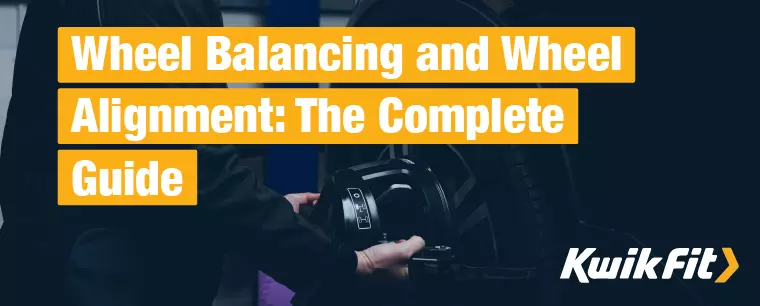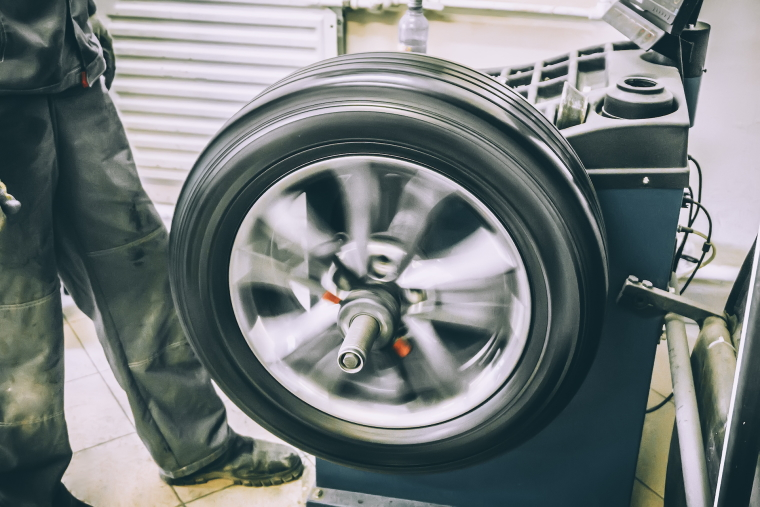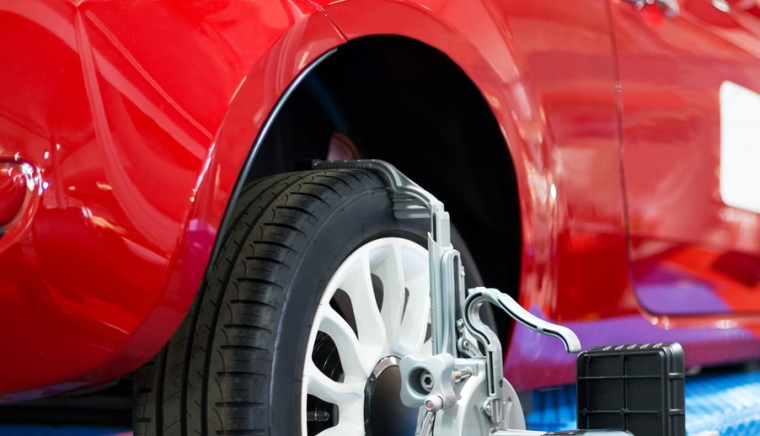Wheel Balancing and Wheel Alignment: The Complete Guide
Jack Dreyer | Thursday 6th July 2023 12:00pm

Until something goes wrong, most of us donít give much thought to the wheels on our cars. This is despite the fact that the condition of wheels and tyres are absolutely essential for smooth, safe contact with the road.
Wheel alignment is one of the most commonly overlooked areas of car maintenance. But what actually is wheel alignment? Why is it important? And how does it differ from wheel or tyre balancing? Hereís your essential guide to getting your wheels ship-shape, and keeping them that way.
Whatís the difference between wheel alignment and wheel balancing?
One of the more common questions that we get asked in our centres is if wheel balancing (also known as tyre balancing) and wheel alignment are two terms used to describe the same thing.
After all, they sound very similar and both aid the long term health of your tyres.
Balancing and alignment are in fact two very different practices. While balancing addresses the distribution of weight around the wheel, alignment looks at the position of the wheels in relation to the road and each other. Itís easy to confuse the two, so hereís a closer look at each one and the benefits this can bring to you and your car.
Wheel balancing
Wheel balancing ensures that the weight of a car is distributed equally around the wheel and that the tyre rotates evenly. This involves adding small balancing weights to the rim which counter weight inconsistencies.
If you imagine a set of balancing scales, when you add a heavy weight to one side the scales will tip. If you then add a number of smaller, less heavy items to the other side, the scales will gradually begin to tilt the more you add until finally, when you have added enough smaller weights, the scales will once again level out. Add too many weights and the scales will tip the other way.
Although this is a simpler example, wheel balancing works in the same way and, if an imbalance towards one side of the wheel is identified, wheel weights are added to the opposite side to even out the distribution of weight.
Why does wheel balancing matter?
Itís important to address wheels that are not correctly balanced to ensure you receive the best ride comfort. Incorrectly balanced wheels produce a vibration that is felt through the steering wheel when travelling above a certain speed that can cause considerable discomfort over time. Whatís more, balance issues can cause premature wearing of your tyres, suspension, and steering components.
You can see the negative impact that out-of-balance wheels can have on your tyres in this video:
What happens during wheel balancing checks?
Wheels can be balanced on a wheel balancing machine available at all Kwik Fit centres. The tyre and wheel assembly are mounted on the machine which then spins the wheel to calculate even the slightest variance in weight across the wheel.
The balancing machine then highlights the exact position where a counter weight should be applied and which size of weights to use to correctly balance the wheel.

Now letís move on to wheel alignment.
Wheel alignment
Wheel alignment refers to the angles your carís wheels are set at.
Traditionally, a car's steering and suspension comprised measuring and adjusting the front wheels (front 'Toe' angle) only. However, cars have evolved and are now built for comfort and performance. In order to achieve and maintain a smooth drive the steering and suspension of all four wheels need to be checked and measured. This is why alignment is also known as Ďtrackingí or Ďfour-wheel alignmentí.
The video below contains more information about how wheel alignment works:
What causes wheel misalignment?
Your vehicleís suspension is usually the main culprit if the wheels are misaligned. This is because sudden jolts, jarring, or a heavy impact can disrupt your suspension and throw other components out of alignment. This then affects the way your wheels are positioned.
The following driving scenarios can all cause disruption to your suspension or other issues leading to wheel misalignment:
- Hitting kerbs, potholes, or speed bumps, especially at speed.
- Road traffic accidents and collisions.
- Height modifications made to your vehicle, if the suspension has not also been adjusted to match.
- Worn parts such as suspension springs.
Spotting the signs of misaligned wheels
If youíve been in an accident or experienced any of the situations above, it could be worth booking into a repair centre to get your wheels checked out. You may notice problems with your car following a bump or after driving over a particularly nasty pothole.
Look out for these key warning signs of wheel misalignment:
- Your car tends to drift off to one side while driving. When driving on a straight, flat road you may notice that your car drifts to the left or right under braking. You can do a careful test on this if you arenít sure, by heading to an empty, flat stretch of road and momentarily releasing the steering wheel. In this situation, the drift or pull to one side should be unmistakable.
- Your steering wheel doesnít return to its original position easily after youíve completed a turn.
- Your carís tyres seem to be wearing unevenly. You may not be able to see the wear but if you run your hands over the tyre you may be able to feel if the rubber has worn on the inside or outside edges.
- Thereís an unusual vibration coming from your steering wheel, or it seems crooked.
- Your tyres start to make a squealing noise.
You may still notice some of these warning signs even if you havenít been in an accident or hit a curb, especially if wheel alignment hasnít been assessed for a long time.

What can happen if your wheels are misaligned?
Incorrect alignment of your wheels can have a huge impact on handling, which means you have less control when driving. Your car could become unstable, making it extremely dangerous in urgent driving situations - such as swerving to avoid an obstacle or applying the brakes sharply to make an emergency stop.
Your tyres will also be seriously affected by wheel misalignment. They are likely to wear unevenly and have a much shorter working life. Uneven wear makes the risk of a tyre blowout a very real possibility, as well as affecting handling and the vehicleís contact with the road.
Lastly, misaligned wheels can hit your wallet in the form of poor fuel economy. Youíre likely to spend much more on fuel if you have misaligned wheels, because there will be greater resistance with the road.
How often should your wheels be checked?
Ideally, wheel alignment should be checked once a year. Itís a good opportunity to go when your car gets its annual service. If not included in a basic or interim service, it could be worth upgrading to a full or major service to make sure that wheel tracking is properly checked.
However, if you experience a jolt or collision on the road and have concerns over the way your car is handling, itís definitely recommended that you put wheel alignment checks at the top of your car maintenance to-do list.
What happens during wheel alignment checks?
Wheel alignment should only be checked by an experienced technician. Most repair centres have a specialist wheel alignment machine, which is able to analyse and measure the wheels in relation to each other. This equipment can be highly sophisticated, even using high-definition imaging sensors to ensure absolute accuracy.
Wheels can be adjusted using specialist alignment equipment which measures the following:
- Either just the front wheels: 2-wheel alignment, also known as tracking
- Or, all four in relation to one another: 4-wheel alignment
4-wheel alignment has added benefits, including resetting the steering wheel to a straight position and ensuring optimum performance and driving comfort. At the majority of our centres, we use the Hunter Hawkeye 4-wheel alignment machines, which use a series of high-definition imaging sensors to measure 14 primary alignment angles on your wheels.
These are then compared against our vehicle manufacturer data, ensuring your vehicle is set up perfectly for you to drive. Your technician will check the manufacturer's specifications and make small adjustments to components until your wheels are in perfect alignment. They do this by looking at the following factors:
Toe-in and toe-out.
These terms are used to describe the angles of the front of the tyres, in relation to the back of the tyres. Imagine it like your feet, where your toes are pointing inwards while your heel points outwards, and vice versa.
Negative and positive camber.
This refers to the Ďtiltí of the tyre, either inwards (towards the vehicle) or outwards. This angle can be affected by the jolt of driving over a pothole, as this disrupts your suspension.
Negative or positive caster.
This more complicated concept relates to the angle created by the pivot point of the steering. Think of it as a line stretching from the front to the back of your car. Caster is negative if this line is angled backwards, and positive if angled forwards.
Fix your wheel alignment & balancing issues today
If your vehicle is experiencing wheel balancing or wheel alignment problems, get in touch with the experts at your nearest Kwik Fit who can help you get safely back on the road in no time at all.
Looking for more tyre maintenance? Have a look at some of the other tyre and wheel services that we offer here. And, for more expert advice, be sure to keep up with the Kwik Fit blog.
Any facts, figures and prices shown in our blog articles are correct at time of publication.
Featured Articles
Is it Illegal to Drive With One Headlight?
Saturday 19th July 2025
Wondering if itís illegal to drive with one headlight? Learn about the safety risks and penalties of illegal blown bulbs and why you should fix them promptly.
Air Con in EVs & Hybrids: Experts Answer Your Questions
Monday 30th June 2025
Does air con drain EV batteries? Can you use the air con while charging an electric car? Find out the answers to these questions & more from Kwik Fitís experts.
Why Is Your Car Making a Noise? Fixes & Tips
Friday 13th June 2025
When your car starts making unexpected noises, it can certainly be quite disconcerting; it may be nothing to worry about, but hereís what you need to know.









